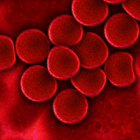Printed from acutecaretesting.org
January 2016
The role of D-dimer in diagnosis of venous thromboembolism – a review
Summarized from van der Hulle T, Dronkers C, Huisman M et al. Current standings in diagnostic management of acute venous thromboembolism: still rough round the edges. Blood Reviews 2015 (released online ahead of publication) available at: http://dx.doi.org/10.1016/j.blre.2015.07.002
The D-dimer blood test is a clinical laboratory test that is also increasingly available at the point of care, most often the hospital emergency room. Over the past decade or so the test has become established for emergency room assessment of patients suspected of suffering deep vein thrombosis or pulmonary embolism, linked conditions that together are termed venous thromboembolism (VTE).
In a recently published review article, the authors describe current recommendations for the precise way in which the D-dimer test should be applied in this clinical context. In short, the recommendation is that a well-validated clinical scoring system should first be applied to all patients suspected of suffering VTE.
This clinical scoring allows each patient to be classified to one of two groups: ”VTE likely” or ”VTE unlikely”. Only patients classified as ”VTE likely” should be submitted directly for diagnostic imaging tests, without undergoing D-dimer testing. The D-dimer test should be reserved for all patients in whom clinical scoring suggests VTE is unlikely.
A negative D-dimer test result (i.e. D-dimer concentration <500 g/L) in a patient whose clinical assessment indicates low probability of VTE is sufficient evidence to safely exclude the diagnosis. A positive D-dimer test (i.e. D-dimer concentration >500 g/L) should prompt referral for diagnostic imaging tests, even if clinical scoring suggests VTE is unlikely.
The value of the D-dimer test is that it allows exclusion of VTE without recourse to expensive and time-consuming imaging tests that are themselves associated with risk of adverse effect.
The scope of the review article goes well beyond a simple description of current recommendations and examines recent research that has highlighted deficiencies in the way these recommendations are actually applied in the working hospital environment. They report four ways in which current recommendations may not be adhered to. This first is omission or miscalculation of the clinical scoring system.
The second is referring patients directly for imaging studies without first applying clinical scoring and/or D-dimer testing. The third is conducting imaging tests despite a “VTE unlikely” clinical score and a negative D-dimer test result. And the fourth is not referring patients for imaging test if clinical scoring suggests VTE is likely but D-dimer testing reveals a normal (negative) result.
The authors discuss the consequences of lack of adherence to recommendations and ways in which adherence might be improved. Other related issues discussed in this paper include diagnosis of recurrent DVT; and the potential for age-adjusted D-dimer thresholds to improve the specificity of D-dimer testing, and thereby avoid some patients being exposed to the radiation required for the imaging test usually used to diagnose/exclude pulmonary embolism.
Read more about d-dimer:
- Causes of increased D-dimer
- Age-adjustment of the D-dimer cut-off value to improve the exclusion of thromboembolic events in older patients
- The clinical use of a D-dimer assay
- Comparing D-dimer assays using likelihood ratios and Fagan nomograms
- Assessment of plasma D-dimer as a diagnostic and prognostic aid for abdominal aortic aneurysm
- D-dimer assays - pitfalls of analytical comparisons
May contain information that is not supported by performance and intended use claims of Radiometer's products. See also Legal info.
Register for the related webinar
The Benefit of Using a D-dimer Assay with a High Clinical Specificity
Presented by Karin Strandberg, MD, PhD, Assoc. Prof.
Join the webinar






